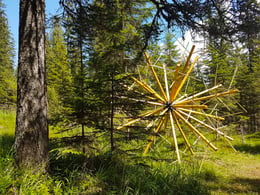Login
Registered users

He doesn’t like labels and fads. His style and philosophy are very clear. He’s one of the most significant graffiti artists in the world today and, while he takes in, and is stimulated by, what’s going on in North America, he never simply copies it. The style of Alessandro Ferri, a.k.a. Dado, is deeply Italian. It rivals contemporary art for its power to trigger discussion but underlying it is the necessity to “disappear.” It might seem paradoxical for a street artist who’s part of a movement that often wants to leave its mark outside places dedicated to art (such as exhibitions and galleries), yet it’s that paradox that defines its power and uniqueness.
Born and raised in Bologna, where he still works today out of his workshop, Dado has traveled the world leaving a trail behind him formed by his personality and art, which today is recognized for the sophisticated interplay of colors and shadows that make his images almost three dimensional, his ability to tune into the surrounding architectural and urban setting, and for his collaborations with important institutions (not just towns). His work isn’t limited to graffiti art and murals, though, with a significant part of his output comprising sculpture and installation art, some of which is displayed in prestigious galleries.
Alessandro, where did the passion come from that’s brought you to a place where art critics like Renato Barilli now describe you as one of the major proponents of Italian street art (such an important movement at the moment) and talk about you in the same breath as New York graffiti artists Keith Haring and Jean-Michel Basquiat?
"It started when I was 12 and, like a lot of teenagers in the 1980s, I graffitied walls. I wasn’t making any political statements. I was just fitting in with a certain youth stereotype, but I combined it with a pretty progressive outlook. After that, my training continued in the traditional way, at high school and then art school, which also brought out my natural passion for sculpture. I eventually combined the qualities of painting with the forms of sculpture – centering in particular on the Italian culture of the 20th century – to the point of creating a low and high relief effect, which I first used in my graffiti art. This work, which was exhibited at the PAC-Padiglione di Arte Contemporanea in Milan, meant translating the language of street art and true graffiti art to a much more conceptual and rational language, extrapolated from the world of art. The basic idea was to give prominence to bas-relief and tone-on-tone effects within the forms of graffiti art. That’s why I used lumen – a type of paint that ensures that, when they’re facing the wall, the viewer will cast a shadow. In other words, it lets you “deface” the work with your presence, therefore overturning the nature of graffiti itself: it’s the viewer who’s defacing the graffiti, not the graffiti defacing the city. This is just one example of what disappearing means to me. I look for oxymorons with my art. That’s my style, and it sometimes meant breaking the law to get myself known".

So, that was how it started. Taking a leap in time to today, what are you currently working on?
"The most important thing I’m doing at the moment is the work at the new Bonfiglioli headquarters in Bologna, where, in the atrium, I’ve created a 118-foot work about metamorphosis. I imagined people going back to work after the weekend and translated it into an image in which chaotic, fluid shapes grow into a regular order, all playing with isometric elements and colors related to the company’s line of business. As you pass by the work, it’s easy to see this change, which also corresponds to a different human perspective".
Your works are sometimes very different from each other, but is there a form that you feel is more your own?
"Distorted, twisted ribbons are definitely the element I most identify with. But I always try to interpret the setting in which I find myself. This approach reflects my chameleon nature, which has sometimes led me to work with angles, grid patterns, precise measurements, and colors that reflect the surrounding architecture".
Do you still have a passion for sculpture?
"Absolutely, yes. One of my sculptures, Letter A, which is at least ten years old and has been on display for a long time in Miami, was just returned to me. It’s made of resin-coated paper and mesh – a medium created by me that’s more unique than rare, and possibly only used by a handful of Japanese artists and me. But this work is a prototype, because, in my opinion, prototypes are often more beautiful than the finished works. It’s one of my most popular pieces, as well as one of my favorites".

>>> Discover a home in Cortina designed by Angelo Micheli, which houses works by Alessandro Ferri.













All images courtesy of Alessandro Ferri